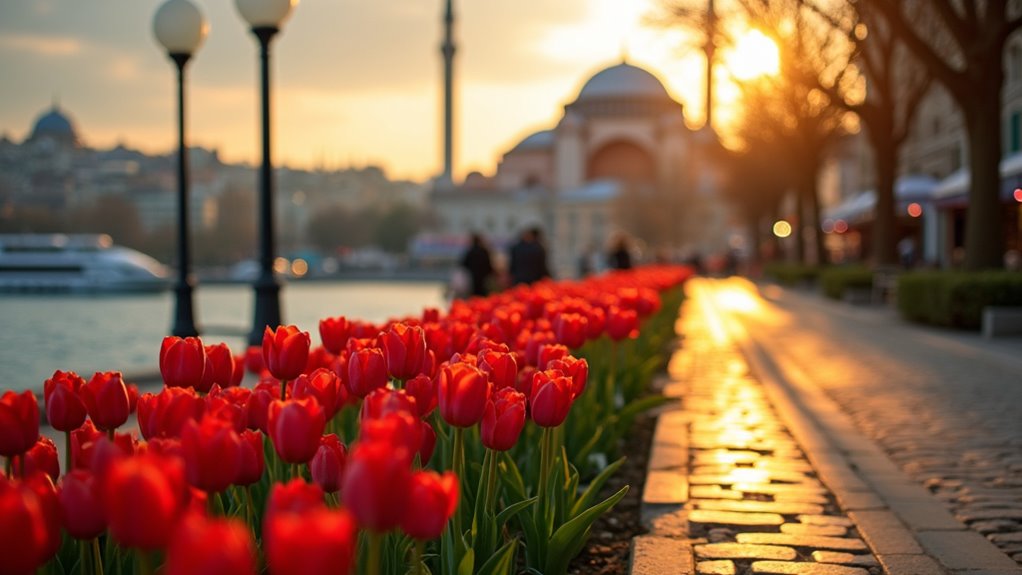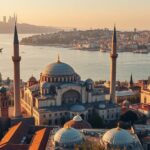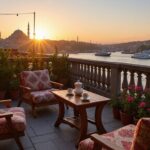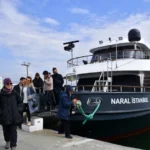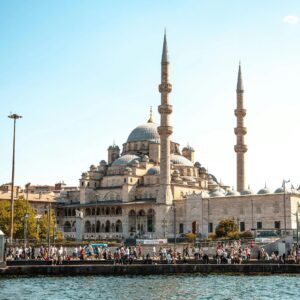Spring in Istanbul offers mild weather, tulip displays in parks, and manageable museum lines for sightseeing. Early autumn brings pleasant temperatures, neighborhoods, and smaller crowds for Bosphorus cruises. Summer provides long sunny days, lively festivals, rooftop bars, but expect peak crowds and higher prices. Winter offers misty streets, lower hotel rates, and quieter monuments for exploration. Plan your mornings at Hagia Sophia, use the Istanbulkart for trams and ferries, and you’ll find more tips ahead.
Key Takeaways
- Best months are April–May and September–October for mild weather, good light, and fewer crowds.
- Visit in winter (November–February) for lowest prices, quieter attractions, and misty atmosphere.
- Summer (June–August) offers festivals and long days but brings heat, large crowds, and higher costs.
- To avoid lines, book timed tickets, arrive at Hagia Sophia early, and visit major sites midweek.
- Explore lesser-known neighborhoods like Balat, Fener, and Kadıköy for local vibes, fewer tourists, and affordable dining.
When to Visit: Seasonal Overview
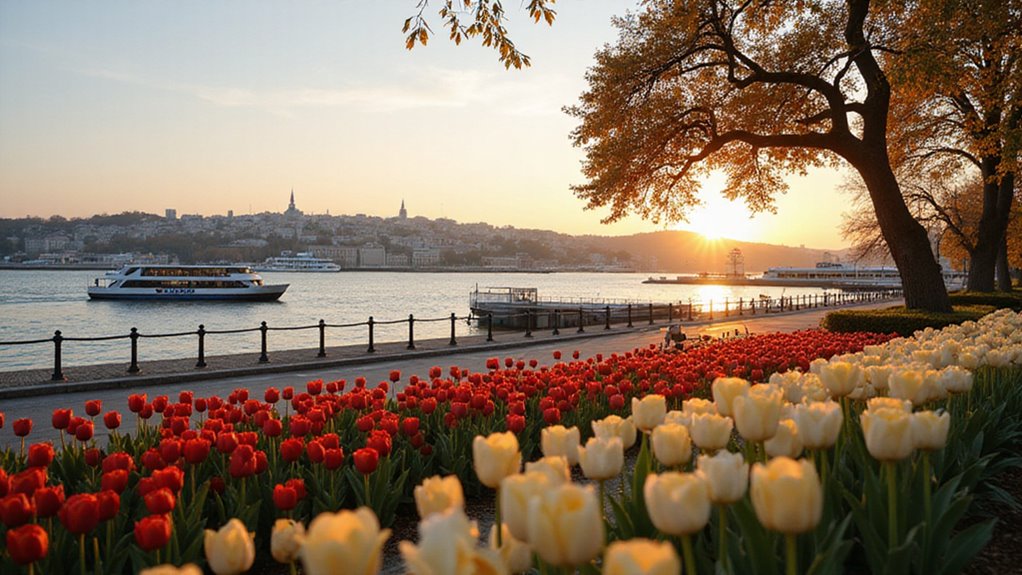
Istanbul’s Sultanahmet and modern Karaköy display different seasonal charms, so you’ll want to plan. Sultanahmet offers iconic monuments, guided tours, efficient tram links, and easy walking routes that you can follow. Karaköy provides lively cafes, contemporary galleries, ferry connections, and quick access to the Bosphorus for scenic crossings.
Sultanahmet in spring draws crowds for spring festivals, practical museum hours, and comfortable daytime temperatures that support exploration. Karaköy in autumn shows vivid autumn colors along waterfront promenades, reliable tram transfers, and excellent dining options for relaxed evenings.
Sultanahmet recommends booking timed-entry tickets, bringing layered clothing, and allowing extra time for lines. Karaköy suggests using ferries, reserving weekend tables, and planning sunset walks.
Sultanahmet and Karaköy both reward flexible itineraries, smart transit use, and early starts, so you can enjoy major sites, scenic views, local food, and cultural highlights with freedom and confidence. Maps help you optimize daily routes efficiently.
Spring in Istanbul: Tulips, Mild Weather, and Festivals
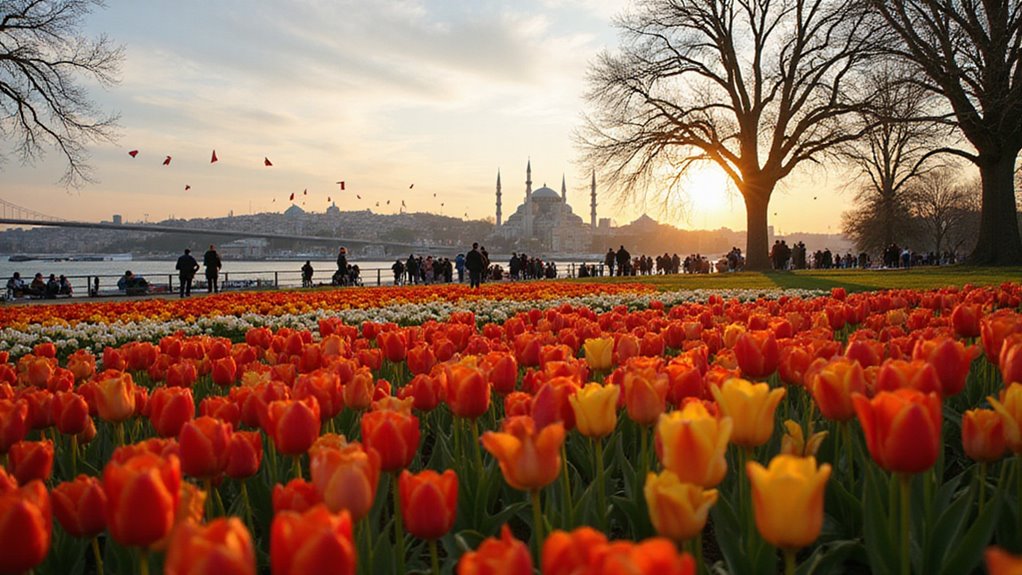
Sultanahmet and Karaköy glow in spring, when tulips blanket parks and mild weather makes walking between monuments enjoyable. Visit Sultanahmet Square, Topkapi Palace, Hagia Sophia, and the Blue Mosque for iconic, compact exploration.
Take tram routes, ferries, easy metro lines, and taxis to move efficiently across the city. Explore Emirgan Park, Gülhane Park, and local gardens where tulip festivals draw crowds and colorful displays.
Walk Istiklal Avenue, sample street food, visit Galata Tower, plan ferry trips to the Asian shore. Pack layers for variable temperatures, carry a compact umbrella, book flexible accommodation near transit hubs.
Visit museums early, reserve guided tours, skip long lines, and use museum passes to save you time and money. Take Bosphorus cruises in calm weather, photograph waterfront mansions, enjoy local seafood restaurants along the shores.
Explore local markets, plan weekday visits to avoid crowds, and embrace the mild climate to wander freely.
Summer Highlights: Long Days, Outdoor Life, and Peak Crowds
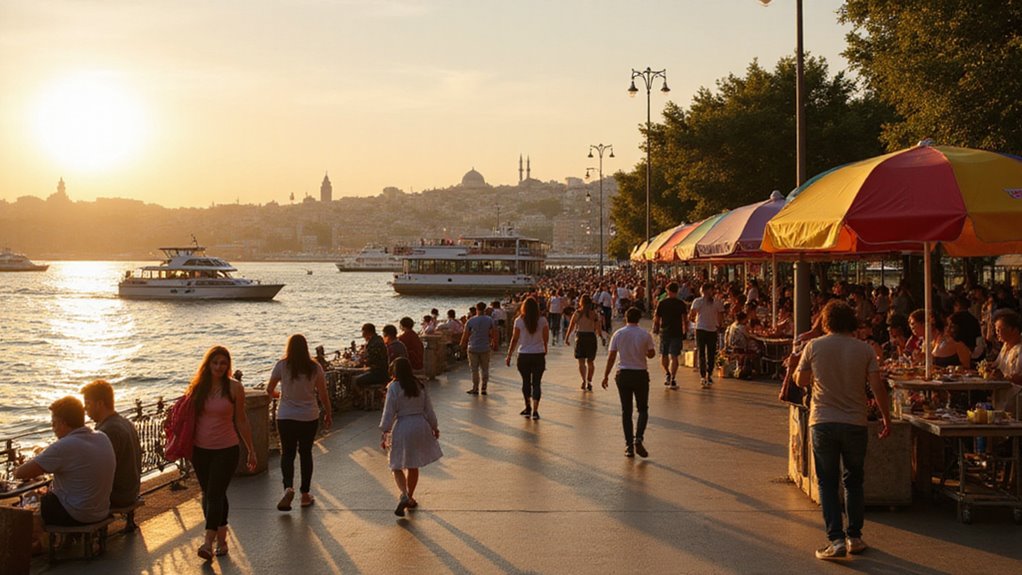
Bosphorus cruises turn into golden, breezy escapes in summer, giving you long daylight hours and dazzling skyline views.
Taksim Square gives you lively streets, food vendors, and straightforward access to trams and metros.
Galata Tower rewards you at sunset with panoramic vistas, buy timed tickets to skip long lines.
Sultanahmet delivers historic sites, walking routes, and heavy daytime crowds that peak in July.
Beach escapes await on the Princes’ Islands and nearby coasts, check ferry times and capacity.
Rooftop bars provide evening coolness, make reservations, enjoy skyline cocktails after sunset.
Ferry rides connect neighborhoods efficiently, carry sunscreen, water, and a hat for sun protection.
Public transport is reliable, use Istanbulkart for trams, ferries, metros, and buses to save money.
Accommodation options include boutique hotels, sea-view apartments, and hostels near major landmarks, book early.
Travel planning benefits from early bookings, flexible itineraries, and awareness of festivals to avoid congestion.
Autumn Advantages: Cooler Temperatures and Local Vibes
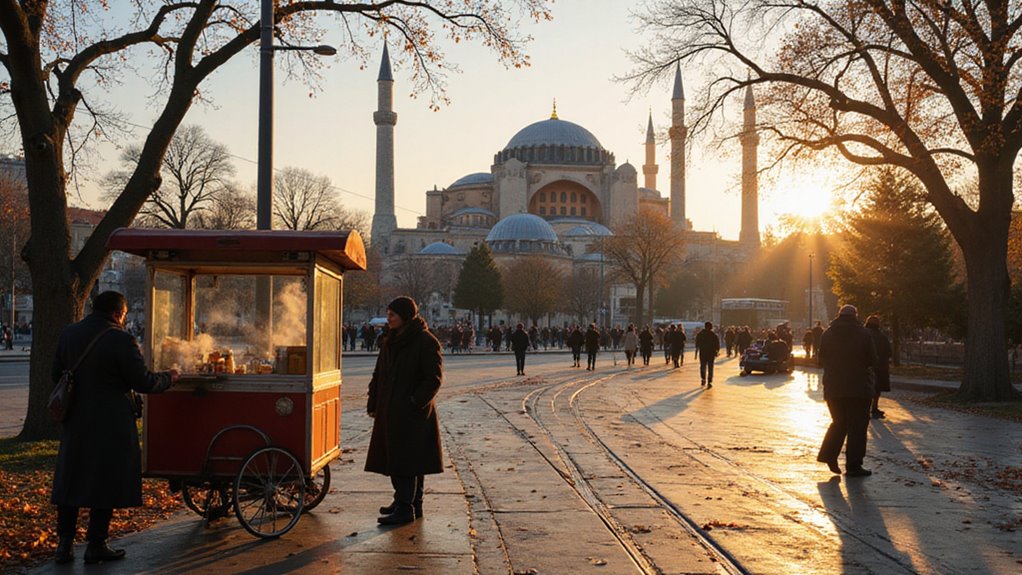
Galata and Kadıköy offer cooler breezes and authentic neighborhood life as summer crowds thin, making wandering streets and cafes more enjoyable. Sultanahmet presents iconic monuments, convenient transit links, and routes for efficient sightseeing. Take the ferry and you’ll reach the Asian shore for varied eateries, vibrant markets, and relaxed promenades.
Bosphorus cruises connect neighborhoods, provide skyline views, and offer comfortable seating for longer trips. Explore local markets for seasonal produce, artisanal goods, and friendly stallholders who welcome questions.
Kadıköy ferries run frequently, fares are low, and transfers to trams simplify onward travel. Visit museums early, book timed tickets online, and save time for spontaneous neighborhood wandering.
Taksim offers lively dining, late buses, and practical accommodation choices near major transit hubs. Consider shoulder-season planning to avoid peak crowds, still enjoy mild weather, and combine city touring with occasional beach activities or pre-season winter sports promotions.
Galata invites relaxed exploration.
Winter Charm: Rain, Fog, and a Quieter City

Kadıköy invites you to explore misty streets and cozy cafes when winter rain softens the city.
Sultanahmet offers dramatic silhouettes of mosques, museums, and sheltered courtyards to wander slowly.
Galata rewards photographers with foggy vistas, narrow lanes, and lively local shops to discover.
Take a ferry across the Bosphorus for brisk views, short crossings, and easy connections to neighborhoods on both shores.
Visit museums, art spaces, and historic inns, planning shorter outdoor segments and longer indoor visits during wet spells.
Walk the waterfront at your own pace, enjoy quiet cafes, misty mornings, and scenic tea stops along the route.
Choose public transit for reliability, use trams, metros, and ferries to avoid traffic delays.
Bring waterproof layers, sturdy shoes, and a compact umbrella for practical comfort.
Book a centrally located hotel near transport links to maximize flexible exploration.
Reserve tickets in advance, especially for popular sites during holiday weekends.
Weather Month-by-Month Guide
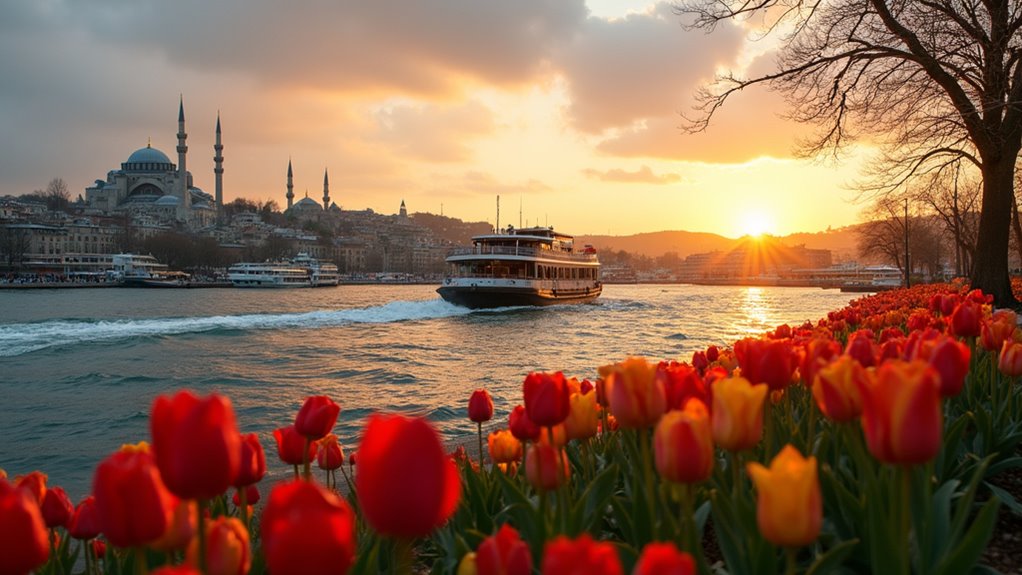
Sultanahmet feels atmospheric in winter, so you’ll benefit from a month-by-month weather guide for planning. Take January for crisp days, expect occasional snowfall patterns, freezing mornings, and shorter sightseeing windows.
Visit February for quieter streets, bundled layers, and efficient museum routes, with light rain possible.
Explore March when temperatures rise, ferry services resume fuller schedules, and annual rainfall increases moderately.
Walk April to enjoy blooming gardens, manageable crowds, comfortable daytime warmth, and reliable tram connections.
Take May for long daylight, café terraces, active boat tours, and straightforward transfers.
Enjoy June with sunlit walks, busy sites, advance ticketing, and clear ferries easily.
Galata July brings hot afternoons, seek shade in parks, hydrate frequently, and prebook popular viewpoints.
Taksim August is peak season, plan flexible itineraries, expect crowded ferries, and use early mornings for photos.
Princes’ Islands September offers cooler breezes, calmer streets, and scenic bike routes for freedom-seeking travelers.
Major Festivals and Cultural Events to Plan Around
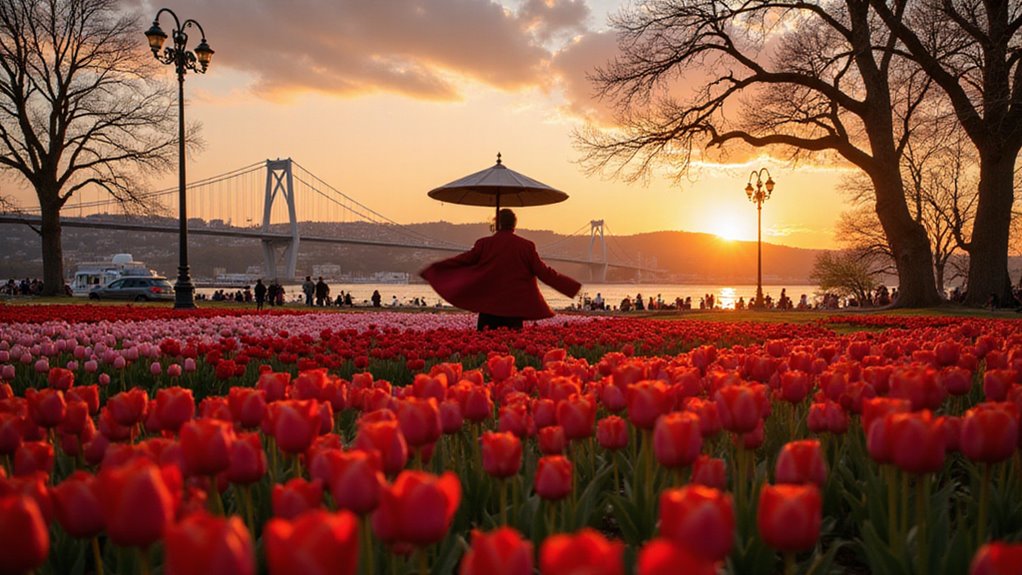
Istanbul’s festival calendar varies by season, so you’ll find events showcasing music, film, art, and culinary traditions across the city. Visit Sultanahmet for outdoor concerts and nearby street food stalls, close to major tram lines.
Attend the Istanbul Jazz Festival and other music festivals, booking tickets months ahead to secure seats. Explore Karaköy for cutting-edge art exhibitions, galleries, and lively cafes near ferry terminals.
Plan transportation by tram, ferry, or metro to reach venues, allow extra time for crowds. Check hotel proximity to venues, choose neighborhoods like Beyoğlu, Kadıköy, or Sultanahmet for very easy access.
Walk the Bosphorus waterfront at dusk to reach nighttime concerts, enjoy illuminated views and convenient ferry links. Choose quieter months like late autumn to enjoy smaller crowds, while still catching notable festivals and pop-up events.
Reserve tickets online, carry an Istanbulkart, and confirm event schedules to make your festival experience smooth and rewarding.
Best Times for Sightseeing and Museum Visits
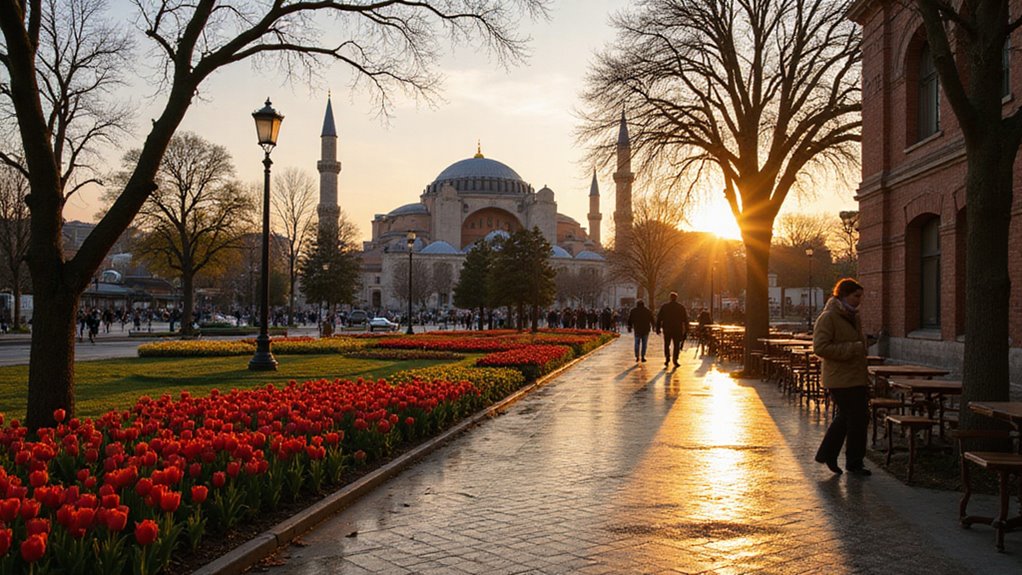
Visit the Hagia Sophia early, and you’ll beat crowds while enjoying soft morning light and cooler temperatures.
Tour the Topkapi Palace midweek to avoid lines, explore courtyards, and see imperial chambers.
Visit Topkapi Palace midweek to skip queues, wander its courtyards, and glimpse imperial chambers.
Explore the Istanbul Archaeology Museums in the afternoon, check schedules, and note possible museum closures during holidays.
Visit the Museum of Turkish and Islamic Arts on weekdays for quieter galleries and clear displays.
Plan art exhibitions ahead, reserve timed tickets online, and arrive early to maximize viewing time.
Wander Istiklal Avenue evenings to scout galleries, small museums, and local exhibitions before crowds swell.
Visit the Blue Mosque return times into your daily plan, allowing for prayer schedules and quieter periods.
Check transport links, tram routes, and walk distances between Sultanahmet, Eminonu, and Karakoy to save time.
Book guided tours for complex sites, confirm opening hours, and keep a flexible agenda to embrace freedom.
Enjoy peaceful museum mornings.
When to Catch Bosphorus Cruises and Ferry Rides
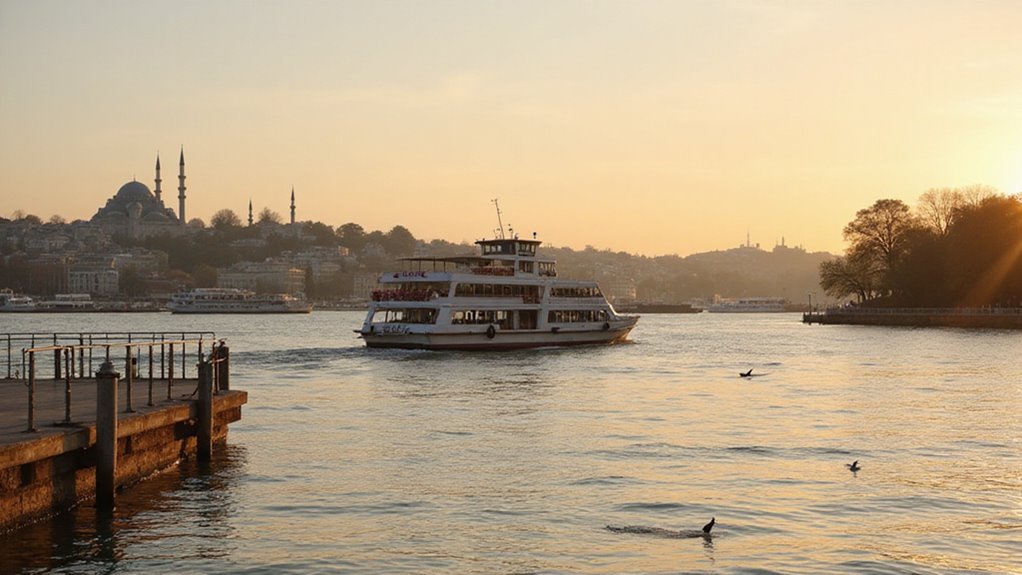
Bosphorus cruises offer a panoramic way to see palaces, waterfront mansions, fortresses, and bridges up close. Take an early morning ferry to avoid crowds. Galata departures often run by schedule, so book ahead for flexibility and lower fares.
Catch sunset cruises for golden views, dramatic silhouettes, and softer crowds in late afternoon. Eminönü piers connect you to short public ferries, offering local color and quick crossings.
Join longer private boats for detailed narration, historic stops, and invigorating sea breezes. Kadıköy routes give you a lively Asian-side perspective, with skyline views and calmer queues.
Book moonlight voyages on clear nights to see illuminated monuments, glittering waters, and tranquil passage. Bosphorus night sails suit free-spirited travelers seeking serenity, efficient boarding, and memorable skyline photos.
Take refundable tickets when schedules change often. Plan transfers from Kabataş terminals early, allow extra time for boarding and inspections. Enjoy unobstructed views from upper decks.
Timing for Food Markets, Street Food, and Culinary Events
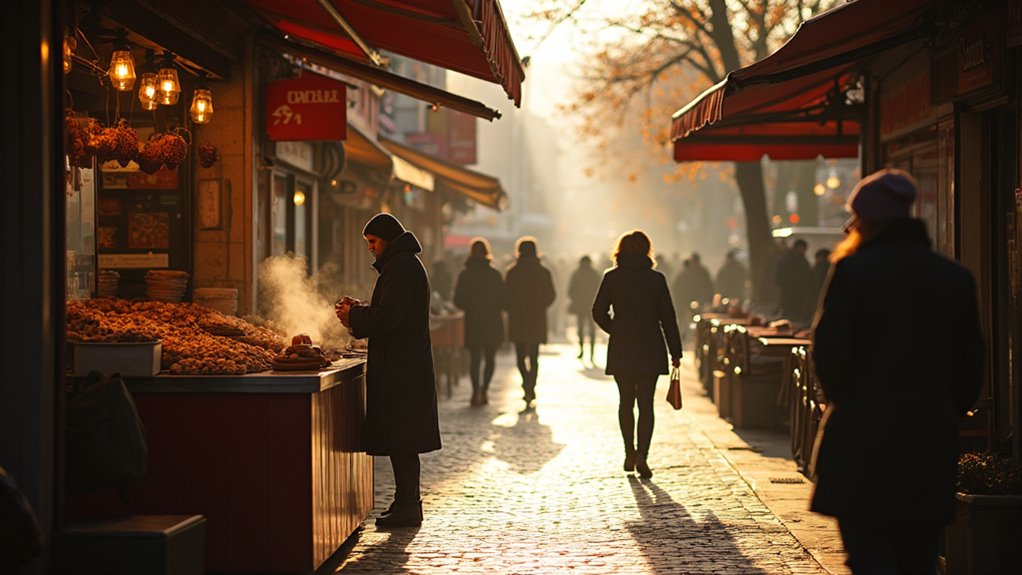
At the Spice Bazaar and Karaköy markets, you’ll find morning street food and colorful stalls. At Karaköy, vendors sell fresh fish, pastries, olives, and aromatic spices.
Visit street food stalls early for the best, most authentic bites and lively scenes. Explore seasonal ingredients at neighborhood markets, taste citrus, figs, mushrooms, and greens.
Visit stalls at dawn for authentic bites; savor seasonal citrus, figs, mushrooms and leafy greens.
Join food tours for guided sampling, local stories, and efficient neighborhood navigation. Take early morning trips to beat the heat, enjoy calm streets, and secure seating.
Sample simit and balik ekmek by the water, savor crusty bread, warm fish, and lemon. Walk to nearby cafes, museums, and waterfront promenades, combine tastes with sightseeing.
Plan transport via tram or ferry, check schedules, and allow time for lines. Book culinary events in advance, confirm menus, and prepare for flexible, flavorful days.
At night markets, enjoy seasonal desserts, live cooking demos, workshops, and regional wine and tea tastings too.
Avoiding Peak Tourist Crowds and High Prices

Sultanahmet sees heaviest crowds midday typically, so you’ll plan landmark visits for early mornings or late afternoons. Grand Bazaar, Spice Bazaar, and Istiklal Avenue can be busy; you’ll time shopping for quieter hours.
Ferry crossings offer scenic transit, and you’ll ride off-peak to avoid crowds and save time. Book hotels in advance, watch for hotel discounts during shoulder season, and choose flexible cancellation.
Historic sites like Hagia Sophia, Topkapi Palace, and Basilica Cistern reward early arrival with calm, clearer views. Public transport maps, timetables, and Istanbulkart reload options help you move quickly, avoiding lines.
Neighborhood walking routes in Karakoy, Balat, and Kuzguncuk reveal local life, quieter cafés, and affordable meals. Timing museum visits after lunch reduces queues, and you’ll book timed tickets online for efficiency.
Reserve restaurants ahead, ask for terrace seating, and you’ll sidestep peak dinner rushes with ease. Bosphorus cruises at sunset fill up; book early.
Best Months for Photography and Golden Light
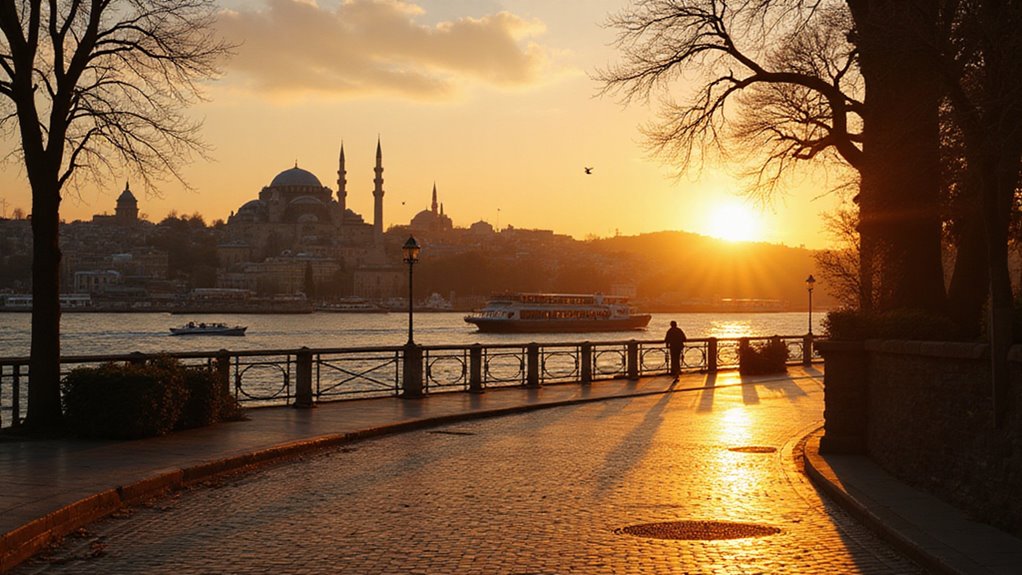
Istanbul’s skyline glows best in spring and autumn, when golden light softens domes and minarets. Sultanahmet is ideal for golden hour shots, with Hagia Sophia framing views. Galata offers rooftop perspective, capturing city layers against warm skies.
Take sunrise photography seriously, arrive early so you can stake out prime vantage points. Bosporus viewpoints reward patient photographers with soft reflections and moving ferries.
Head to Pierre Loti Café, Galata Tower, and Süleymaniye for layered silhouettes at dawn. Topkapi terraces provide historical foregrounds, offering composition options near the Golden Horn.
Plan visits in April, May, September, October, when softer light and milder skies create consistent golden hour windows. Balat streets deliver colorful backdrops, strong contrast, and intimate architectural details for close work.
Arrive before dawn, scout compositions, respect sites, adjust exposure, and capture decisive moments during that fleeting glow. Explore forecasts, refine plans, and return often for varied light.
Practical Travel Tips by Season (Clothing, Transport, and Comfort)
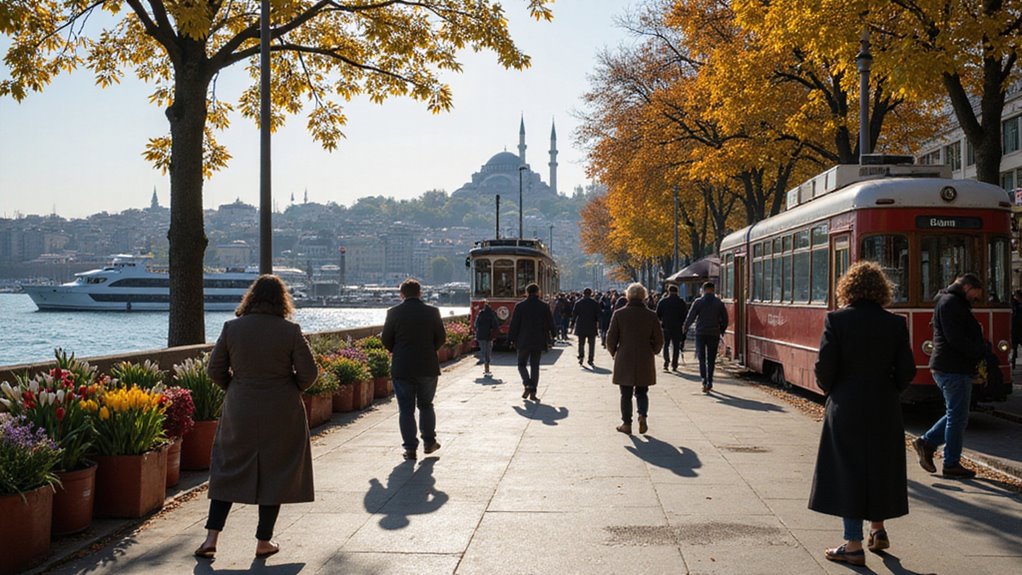
Galata mornings are chilly in spring, so you’ll want a light jacket for golden hour shots. Sultanahmet evenings feel cooler, layer with a scarf and a compact rain shell. Taksim nights reward flexible footwear, bring comfortable walking shoes for cobbled streets.
Pack smart: packing essentials include a foldable umbrella, power adapter, light layers, and a daypack. Bosphorus cruises require sun protection, sunglasses, and a windproof layer for deck time.
Use local transport like trams, ferries, and metros to move quickly between landmarks, avoid traffic. Visit markets and museums early, enjoy cooler temperatures, and skip long lines.
Take taxis selectively, confirm fares with drivers, and use apps for secure rides. Eminonu and Kadikoy offer vibrant restaurants, cafes, and ferry connections for seamless exploration.
Sultanahmet mornings also benefit from early museum bookings, bring printed tickets, and plan routes to save time. Visit ferry terminals early, secure seats for peak crossing.
Family Travel: When Is Istanbul Most Kid-Friendly?
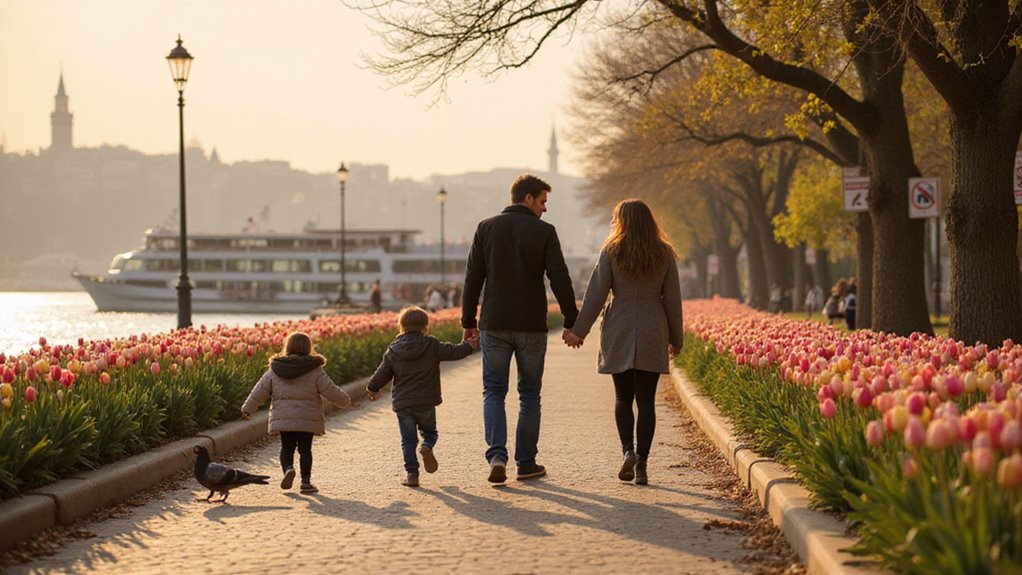
Bosphorus cruises are ideal for families, offering fresh air, short routes, and engaging skyline views.
Sultanahmet museums provide easy walks, stroller access, very clear signage, and interactive displays for kids.
Sultanahmet’s museums offer easy walks, stroller-friendly routes, clear signage, and interactive displays that delight kids.
Take ferries to the Princes’ Islands, enjoy quiet car-free streets, bike rentals, and calm beaches.
Dolmabahçe Palace visits combine short tours, grand rooms, and manageable crowds during off-peak hours.
Visit Istanbul Aquarium for immersive exhibits, clear paths, supervised touch pools, and memorable learning moments.
Taksim and playgrounds offer you snacks, open spaces, safe walking routes, and evening entertainment options.
Explore kid friendly attractions like miniature parks, science centers, and puppet theaters for families.
Sultanahmet tram lines ease transit, provide stroller space, frequent service, and clear connections between sites.
Book accommodations near attractions, prioritize ground-floor rooms, seek family rooms, and check childcare services.
Spring and early autumn bring mild weather, smaller crowds, comfortable days, and flexible family plans.
Budget Travel: Cheapest Months and Money-Saving Strategies
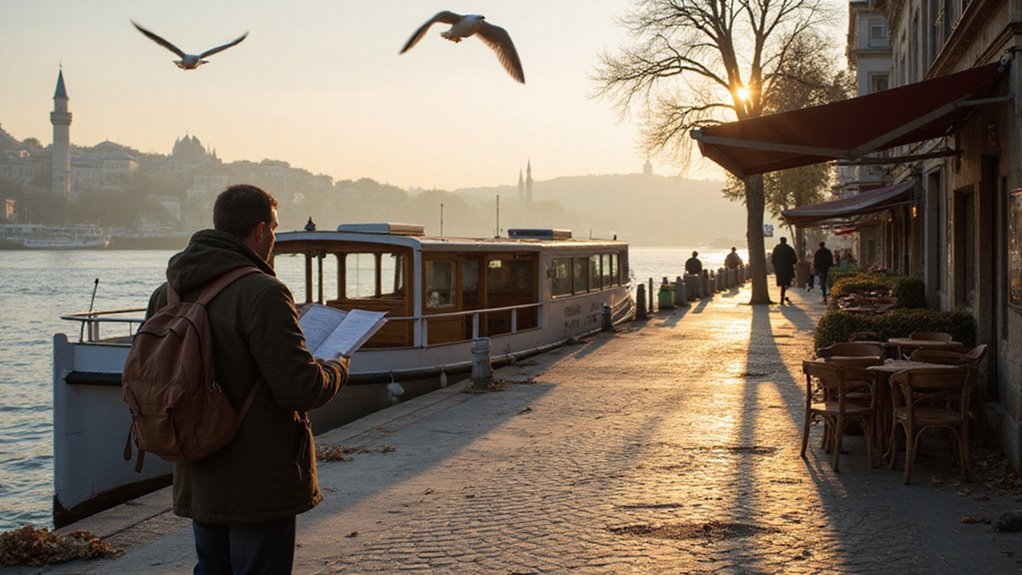
Travel in winter, especially November through February, to find the city’s lowest prices and smaller crowds. Istanbul rewards you with cheaper hotels, quieter museums, and lower flight fares during these months.
Explore budget accommodations in central neighborhoods, where hostels and guesthouses offer safety and charm. Take advantage of affordable dining at street markets, meyhanes, and small family restaurants to stretch your budget.
Use public transport, trams, ferries with an Istanbulkart for easy, economical city travel and scenic Bosphorus views. Sultanahmet, Taksim, and Kadıköy provide walkable attractions, historical sites, cafes, and vibrant markets within compact areas.
Plan free walking tours, timed museum visits, and combined attraction passes to save time, avoid lines, and lower costs. Book flights and lodging early for the best deals, remain flexible with dates, and travel midweek when possible.
Embrace slower pacing, lighter baggage, and local advice to maximize freedom, comfort, and savings while exploring.
Frequently Asked Questions
Do I Need a Visa to Enter Turkey?
Yes, you might need a visa, and coincidentally the visa requirements and entry regulations will vary by nationality, so you’ll easily check online, choose freedom-friendly options, and verify you’re prepared before you travel to Turkey.
Is Tap Water Safe to Drink in Istanbul?
You can drink tap water in Istanbul, but many travelers prefer bottled for safety; water quality is generally good, yet you should take health precautions like using filtered water for brushing or if you’re sensitive.
What Are Typical Tipping Customs in Istanbul?
You’ll generally tip 5–10% in restaurants and round up taxis; small change is fine for cafes. This tipping etiquette follows local service industry norms, but whenever you can easily adjust freely to reward excellent service.
How Widely Is English Spoken in Tourist Areas?
Mostly you’ll get by in tourist areas—English proficiency is fairly high among shop, tour and hotel staff, so tourist communication’s easy; occasional language barriers pop up, but you’ll usually navigate them independently and confidently yourself.
Are ATMS and Card Payments Widely Accepted?
Yes, ATMs and card payments are widely accepted in Istanbul, so you’ll travel freely; watch atm fees at smaller machines, use chip/contactless cards, keep an eye on card security and prefer bank ATMs for withdrawals.


